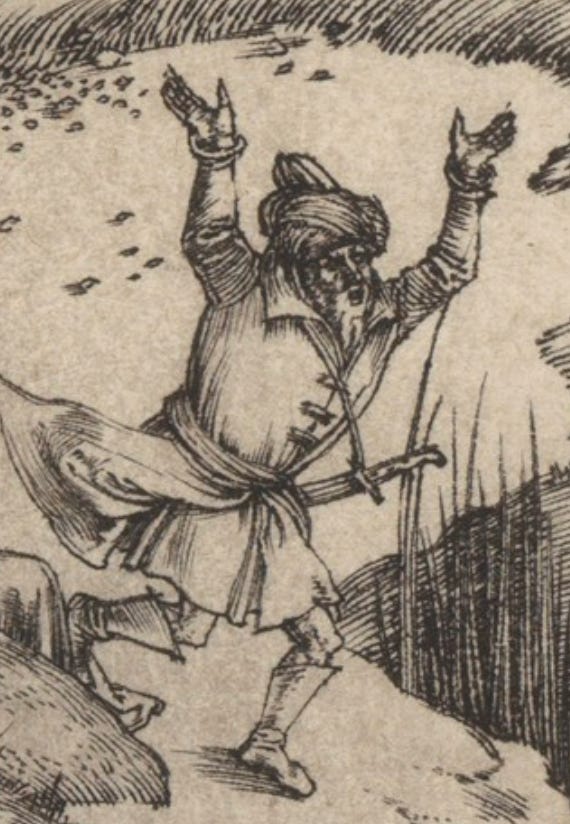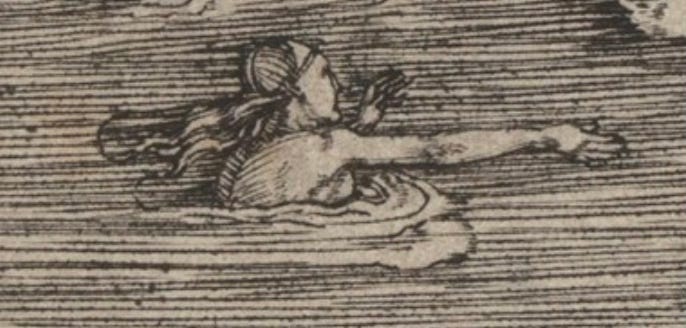The Sea Monster by Albrecht Dürer
Or, an abundance of textures in engraving. But did anyone ask how the princess feels about this?
Once upon a time, a princess was bathing with her friends on the shores of a gentle sea, when out of the water emerged a man with a long fishtail for legs and a single antler bursting from his forehead, armed with a jawbone and a turtle-shell shield. He snatched her by the arm and without giving her time to say goodbye, she found herself heading quickly out to sea, wearing nothing but her bejeweled headdress and a long, silk wrap. She turns, looking back at her agitated friends as they gesture and climb out of the water, to see an armed, turbaned man running towards the water’s edge, his arms raised in protest, appeal, or pursuit. Is she being carried away as a sexual prize, or was she just saved from a different kidnapper? Or is this mysterious narrative an excuse for Albrecht Dürer* to show off his incredible prowess as an engraver, merging his mastery of depicting texture with his knowledge of current developments in Italian Renaissance artists such as human proportion and fantasia?
Figure 1. Albrecht Dürer, The Sea Monster (1498), 9 3/4 x 7 7/16 in. (24.8 x 18.9 cm)
This strange and wonderful engraving by the great Renaissance artist Albrecht Dürer (German, 1471–1528) is known traditionally as The Sea Monster, or in German as Das Meerwunder, or sea wonder. There’s some debate about whether the engraving illustrates a particular story, myth, or phenomenon; but I think Dürer took ideas from several sources and invented his own complex scene: a fantasia of an artwork, you might say. This allows us to look closely and wonder at all the textural contrast in a single scene.
If you’re thinking, hey, there are some real similarities to Mantegna’s Battle of the Sea Gods (from my newsletter published August 16, 2024, which also defines fantasia), you would be absolutely right! Dürer had traveled to Italy from his hometown of Nuremberg, and borrowed it for enough time to carefully draw his own copy. Dürer’s copy of the Battle still survives (in the Albertina collection in Vienna)! The slow act of copying by hand not only gave him a record of the print to take with him, it also taught him the engraving style of Mantegna, which he could choose to incorporate into the development of his own style.
Figure 2. Albrecht Dürer’s drawing after Andrea Mantegna’s Battle of the Sea Gods
Dürer’s sea monster looks like he could be the older great-uncle of Mantegna’s sea creatures. Although he has a longer, shaggier beard and mustache, he sports a muscular torso and his lower half is a long, scaly fish body ending in a fanned fishtail. He also carries bones as weaponry, though his sea turtle shell seems a bit more practical, not to mention more logically of sea-origin, than the skull-shields of the Battle. The abducted princess rides on his back somewhat like the nereids in the Battle, though her drapery winds under and around her rather than arching over her head.


Figure 3. Details of Mantegna, Battle of the Sea Gods (L) and Dürer, Sea Monster (R)
While these two central characters do owe a debt to Mantegna, Dürer did not emulate the long horizontal proportion of the Battle of the Sea Gods but rather changed the orientation of his scene to tall and vertical. This allowed him to include an elaborate landscape with much more in the background than Mantegna’s Battle. A fortified township nestles into the land, with fortifications, half-timbered houses, turrets, crenellations, and steeply pitched roofs; the land stretches up with steep cliffs to a pinnacle featuring another castle towering into the clouds above. This deeper landscape setting heightens the narrative interest with a sense of place, gives enough space to allow more figures to agitate on the shore, and sends us looking back to admire such far-away details as the magnificent ship on the horizon on the far right side. It also places the fantastical events in a contemporary, northern-European setting with architecture that his audience would recognize.
Figure 4. Background detail (the upper half) of Dürer’s Sea Monster
This print is a tour de force of textural variety, as Dürer has rendered an extraordinary amount of different materials. Look at the many distinct types of plants he included! Conifers and deciduous trees, reeds and rushes, bushes and shrubs. Other natural textures include the turtle shell, bone, fishtails, scales, antler, rocks, hair, beard, flesh, clouds, water placid, waved, rippled, and frothy; and man-made textures such as silk drapery with its gathers and puckers, jewels, pearls, and ribbons, not to mention all the architectural materials he depicts in the buildings on land.
Engraving involves carving copper with a sharp tool, a process requiring precision and strength. Every mark or groove made by the carving tool, called a burin, gets filled with ink and marks the paper under a press. If you’re curious and want to know more, there is a terrific explanatory video showing the making of an engraving on the website of the Metropolitan Museum of Art to which I will link below. Engraving lends itself to uniformity sometimes (as you may notice if you watch the video) because of the sustained effort it takes to cut through metal. This print is one of several true showpieces of engraving versatility by Dürer—I’d love to show you more!
When I said above that Dürer was “showing off his prowess” as an engraver, I spoke deliberately. By now you have probably noticed, even if it is depicted in shadow, just where the sea monster’s torso turns from a man’s into a fish, way below his belly button. It would have been quite doable for the princess’ silk wrap to discretely cover him up, and Mantegna’s naked sea gods and ichthyocentaurs are quite modest by comparison. It turns out that this sea monster has the same type of penis as those of satyrs in contemporary prints, and satyrs were another kind of part-man who were famous in the Renaissance (and in antiquity) for their unbridled and unreasonable sexual appetites. The princess’ hand, with an unusual gesture for one being dragged out to sea, is also placed strategically.
Figure 5. Detail of Dürer’s Sea Monster
We assume, because of similarities with stories from myth such as the Rape of Europa, that she is being carried off for this specific nefarious intent, but it could also be that she was in a similar danger on shore: look at the deliberate placement of the scabbard of the man with a turban that runs toward them. His turban also renders him untrustworthy in the eyes of Dürer’s contemporary audience, as the Ottoman Empire was about to reach its greatest territory and had made violent incursions into Europe.


Figure 6. Details of Dürer’s Sea Monster
We guess his identity from his headgear, which is an Ottoman turban; and we also know that the woman I’ve been calling a “princess” has the headdress of an aristocratic northern Italian lady, the height of fashion right around 1500. In a future post, I will write about how paintings of women in profile—as this princess nearly is—featured their jewels, hair, and headdresses in portraits made on the occasion of their weddings—sometimes with a greater “accuracy” than their actual features. In featuring very contemporary costume and architecture, Dürer was also “updating” the scene, placing it in his time rather than in the classical antiquity of Mantegna’s world. Meanwhile, we can understand that the princess looks back towards the shore, but her expression is somewhat inscrutable. What do you think she is thinking? Was she saved or abducted? Is she bored or alarmed? She certainly has a very relaxed pose, like she is reclining on a settee rather than on a sea monster.
Figure 7. Detail of Dürer’s Sea Monster, lower center with monogram
I could go on, but the hour grows late—so let’s return to the princess’ gesture. Whatever it may otherwise imply, she is pointing to Albrecht Dürer’s monogram, his signature D under the A. Whatever the source(s) of the depicted narrative here, the main “subject” of this engraving is Dürer’s talent as an engraver: his fantastic ingenuity in updating and incorporating current Italian artistry (such as Mantegna’s Battle) and an ability to depict an ideal human proportion. I can develop that theme at greater length in a later post, but for now I’ll leave you with this last, humble detail:


Figure 8. Detail of Dürer’s Sea Monster (L), and Dürer’s Great Piece of Turf (R)
The improbable reedy grasses in the lower right hand corner of the engraving remind me of Dürer’s gorgeous, and extremely moving, watercolor/gouache of the Great Piece of Turf in the Albertina collection. What is this patch of grass doing in the engraving, if the princess and the sea monster are heading to an open sea? Or maybe it points to the marshland of the Battle of the Sea Gods, as it marks the lower edge of the print? Or maybe, Dürer is just someone who can—like you, dear reader who has made it all the way to the end—appreciate and linger on beauty of the smallest, humblest details like a patch of weeds or reedy marsh.
Bonus detail: I really love this swimmer, a woman with flowing hair who pushes forward in the still water, creating a wake behind her and a bit of froth before her. Look at the movement of her arm stretching forward and her hair flowing backward, and her delicate profile capturing that movement and grace.
Artwork above:
Figure 1. Albrecht Dürer, The Sea Monster (1498). Engraving, 9 3/4 x 7 7/16 in. (24.8 x 18.9 cm). This impression is in the Metropolitan Museum of Art, NY
Figure 2. Albrecht Dürer, Drawing after Andrea Mantegna’s Battle of the Sea Gods (1494). Pen drawing, 289 x 381 mm. Graphische Sammlung Albertina, Vienna
Figure 3. Details of Mantegna, Battle of the Sea Gods (L) and Dürer, Sea Monster (R)
Figures 4-9. Details of Dürer’s Sea Monster
Figure 8.Albrecht Dürer, Great Piece of Turf (Das Grossen Rasenstück), 1503. Watercolor, gouache, and highlights. 40.3 cm × 31.1 cm (15+7⁄8 in × 12+1⁄4 in), Graphische Sammlung Albertina, Vienna
Video referenced above, on the process of engraving: (Content warning: the printmaker is a lefty and it’s a bit stressful for me to watch her carve, because it is a very sharp tool!)
Note the absolutely incredible and detailed print by Martin Schongauer, whom Albrecht Dürer admired, at the top of that webpage. This Christ Bearing the Cross blows me away every time I see it.
*For a brief summary of the accomplishments of this extraordinary artist, see:









